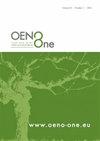New insights about sensory contribution of grape stems during winemaking: role of astilbin, a sweet polyphenol
IF 2.2
3区 农林科学
Q3 FOOD SCIENCE & TECHNOLOGY
引用次数: 0
Abstract
In the usual red winemaking process, grapes are destemmed between the harvest and the filling of the vat. However, in regions like Bourgogne, some winemakers let all or a part of the stems in contact with the juice during vatting. This choice will likely affect the sensory properties of wine, such as its gustatory perception. The present study investigated the effect of adding stems during the winemaking process on the concentration of a sweetening compound, astilbin. The sensory contribution of astilbin in wines was first clarified by measuring its taste detection threshold and comparing it with the concentrations found in various commercial wines. Then, experimental wines resulting from the addition of stems in various proportions were analysed. These practical experiments were carried out in various French wine estates, in Bourgogne, Beaujolais and Bordeaux, over three vintages, allowing the comparison of different grape varieties, namely Pinot noir, Gamay and Merlot. For each experiment, the modality with the addition of stems was compared with a vat of destemmed grapes from the same plot. Samples were taken throughout the winemaking process to be analysed by liquid chromatography coupled with high-resolution mass spectrometry (UHPLC-Exactive, Orbitrap analyser). The results showed that the addition of stems during vatting significantly increased astilbin concentration. Furthermore, this increase varied according to the grape variety. Whereas the astilbin contents were lower in Merlot wines than in Pinot noir or Gamay wines, the ratio between its concentration of wines from the two modalities was higher in Merlot than in Pinot noir and Gamay. The localisation of astilbin in the different components of the bunch, depending on the grape variety, was also investigated to understand this difference better. Thus, a higher abundance of astilbin in stems than in skins was found in the Merlot variety, whereas, for Gamay and Pinot noir, the total quantity of astilbin in a bunch was located in equal proportions in stems and skins. These new results bring new tools to understand better the practice of whole bunch vinification from a chemical perspective.对酿酒过程中葡萄梗感官贡献的新认识:甜多酚 Astilbin 的作用
在通常的红葡萄酒酿造过程中,葡萄会在采摘和装桶之间进行去梗处理。不过,在勃艮第等地区,一些酿酒师会在装桶过程中让全部或部分葡萄梗与果汁接触。这种选择可能会影响葡萄酒的感官特性,如口感。本研究调查了在酿酒过程中添加葡萄梗对甜味化合物天人菊素浓度的影响。首先,通过测量淀粉糖浆的味觉检测阈值,并将其与各种商业葡萄酒中的浓度进行比较,明确了淀粉糖浆在葡萄酒中的感官贡献。然后,对添加了不同比例茎叶的试验性葡萄酒进行了分析。这些实际实验在法国勃艮第、博若莱和波尔多的多个葡萄酒庄园进行,历时三个年份,比较了不同的葡萄品种,即黑皮诺、佳美和梅洛。在每次实验中,都将添加葡萄梗的方式与来自同一地块的一桶去梗葡萄进行比较。在整个酿酒过程中采集样品,通过液相色谱-高分辨质谱法(UHPLC-Exactive,Orbitrap 分析仪)进行分析。结果表明,在酿酒过程中加入葡萄梗会显著增加天青素的浓度。而且,这种增加因葡萄品种而异。虽然梅洛葡萄酒中的芪含量低于黑比诺或佳美葡萄酒,但梅洛葡萄酒中的芪含量比值高于黑比诺和佳美葡萄酒。为了更好地理解这一差异,我们还研究了不同葡萄品种的葡萄串中鞣花青素不同成分的定位情况。因此,在梅洛品种中,茎中的淀粉样蛋白含量高于皮中,而在佳美和黑皮诺中,葡萄串中淀粉样蛋白的总量在茎和皮中的比例相同。这些新结果为从化学角度更好地理解整串葡萄酿造工艺提供了新的工具。
本文章由计算机程序翻译,如有差异,请以英文原文为准。
求助全文
约1分钟内获得全文
求助全文
来源期刊

OENO One
Agricultural and Biological Sciences-Food Science
CiteScore
4.40
自引率
13.80%
发文量
85
审稿时长
13 weeks
期刊介绍:
OENO One is a peer-reviewed journal that publishes original research, reviews, mini-reviews, short communications, perspectives and spotlights in the areas of viticulture, grapevine physiology, genomics and genetics, oenology, winemaking technology and processes, wine chemistry and quality, analytical chemistry, microbiology, sensory and consumer sciences, safety and health. OENO One belongs to the International Viticulture and Enology Society - IVES, an academic association dedicated to viticulture and enology.
 求助内容:
求助内容: 应助结果提醒方式:
应助结果提醒方式:


